February 03, 2008
Setsubun and Mame-maki
Today was setsubun. Some people put a dried fish and a sprig of holly near their entrance. The smell of the fish and the possibility of being poked by the holly will keep bad spirits or bad luck away from the entrance. People throw roasted soybeans out the entrance to get rid of bad spirits and then throw beans inside the entrance for good luck to come inside. Read about setsubun and mame-maki on Kids Web Japan by clicking on the link below. Also read last year's entry.
Kids Web Japan--Setsubun & Mame-maki
Posted by
Annie Donwerth Chikamatsu
at
8:11 PM
0
comments
![]()
Labels: bean throwing, mame-maki, setsubun, soybeans
June 22, 2007
Edamame
Edamame is sold in bundles here. This bundle is taped at the top and at the roots. Sometimes twine or rubber bands are used. People carry bundles of edamame down the streets of our neighborhood during the summer. I once saw a farmer walk into his field, pull up a bundle, and then walk home. Mud dropped from the roots as we walked along. Talk about fresh!
Big Sister cut these from the stems. She used scissors and cut the top of the edamame at a slant. Then, according to Baba's instructions, the edamame were washed in salt water. Then they were put in boiling salt water for a few minutes. We ate them warm. They are also eaten cold. They are a tasty snack.
Posted by
Annie Donwerth Chikamatsu
at
11:25 PM
0
comments
![]()
August 27, 2006
Loose Ends from Our Trip
There were a few pictures that weren't included in any posts about our trip. Perhaps someday there will be a gallery, but for now I'll post these as Loose Ends.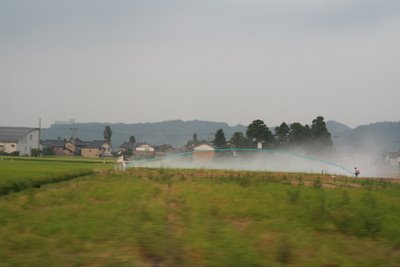
I took this picture and the next one near the inn where we stayed. These guys were using this long blue hose to spray water or pesticides on this field. I have a feeling it was pesticide or weed killer.
I have always been advised (by Papa) not to take photographs in a cemetery. The atmosphere here was different. This gravesite was in the wide open spaces of a rice field, behind a home, and next to a kitchen garden. It was part of the scenery and part of daily life.
It may look like a single grave but it is, in fact, a gravesite for a whole family. The long narrow stone bears the family name. Permanent vases and an incense burner are at the base of the headstone. There is a stone slab at the foot of the headstone and small altar. It covers a small hollow space or tomb. Ceramic jars of the bones of the deceased are placed there. There is a stone to the left of the tomb. The names of the deceased family members and the date of their passing are inscribed on the stone. Once, while scrubbing the stones and pruning the shubbery at our gravesite, I asked Jiji, Grandfather, how many jars could be placed there. He said maybe 15.
This is a picture of a "doorknob" at the inn where we stayed. It was on an interior sliding paper door. Our old house had these kinds of "knobs".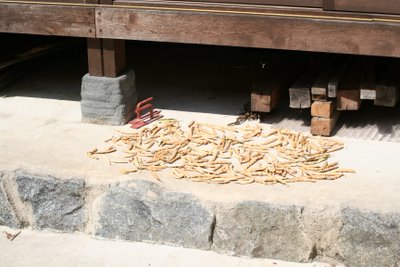
These were soybeans drying in the sun. They were near the foundation of one of the thatched roof houses in Ainokura. In the area outside the village, I saw small bundles of soybeans. They were hanging on the eaves of houses. Dried soybeans are eaten as a snack.
I took this picture of an old mouse trap at the thatched house where I lost my shoes (see August 24). Mouse traps haven't changed much over the centuries. Click the picture to enlarge. Compare the one I posted on August 8th.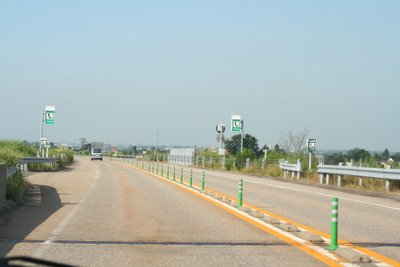
A country road. This highway had two lanes and it had a view. Note, too, the signs (like in Tokyo) that tell drivers there is a telephone up ahead.
Posted by
Annie Donwerth Chikamatsu
at
10:52 AM
0
comments
![]()
Labels: August in Japan, cemetery, doors, highway, houses, pest control, pesticides, soybeans, thatched-roof houses
August 01, 2006
Preparing Summer Vegetables For Sale

The farmers in the field behind our house dug potatoes and left them for a couple of days. They then gathered them and loaded them onto their truck. They took them to wash and to sell.
There are other farmers in the neighborhood. One couple has been farming near our house for over 30 years. They sell their vegetables in a vegetable stand in a parking lot on the north side of our house. Both of them work in the fields and take turns sitting in the stand selling their vegetables. They usually sit in the back. There are two chairs in the front. Customers sometimes sit there to chat with them. The stand is open from 8:00 to 6:00 during the summer months. Their lunch break is from 12:00 to 1:00. The stand is closed in the winter.

Here she is preparing edamame for sale.
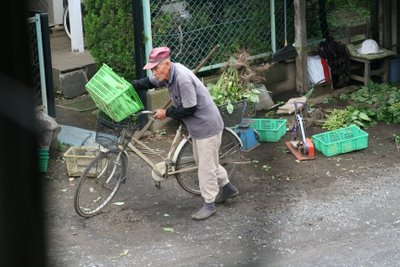
Here he is in the morning going off to get more vegetables.
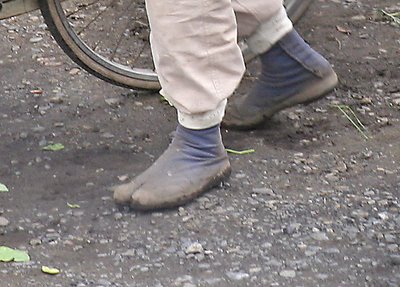
These shoes have always interested me. They fit snugly and have very flat rubber soles. I'm sure they prevent slipping. I have seen construction workers and gardeners wear them, too.
Posted by
Annie Donwerth Chikamatsu
at
11:03 AM
1 comments
![]()
Labels: August in Japan, shoes, soybeans, vegetable stands, vegetables












